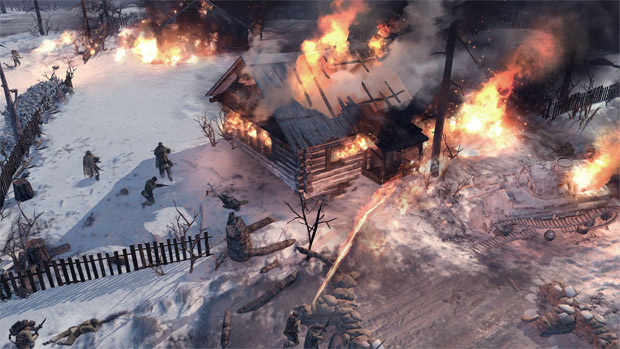Mother Russia has never looked so cold
Playing Company of Heroes 2 at PAX was a trippy experience. Hamza previously covered the game and hit the major points worth highlighting, but I still wanted to share my thoughts on the highly anticipated sequel as someone who isn’t especially into games about World War II, even if they are developed by the fine folks at Relic Entertainment.
After getting the basics down in a beginner-style mission, I entered a more traditional real-time strategy skirmish with capturable control points scattered across the map. An AI-controlled ally and I were separated from the enemy forces by a frozen body of water which ended up being quite the barrier indeed, even for vehicles. The goal was to hold on to various points for longer than the enemy, and of course lesser ones as well that provided further resources for some light base building.
As you have probably heard by now, harsh winters are a crucial part of the game, both visually and in terms of how battles turn out. Between the TrueSight system, which lets you see what your soldiers could believably see down on the ground, random blizzards, and ice fields that are not only slippery but can ultimately crack wide open, there’s a lot to be mindful of.
You can even lose your men to frigid temperatures if you don’t keep an eye on their status; you’ll need to occasionally shelter them from the severe cold to prevent this. It’s not something you need to be worried about constantly, but it is yet another thing to be on the lookout for. Mentally, these factors start to add up, though I believe that cause for concern was made more apparent having skipped the hours of training I would otherwise have had by playing Company of Heroes 2 from the comfort of my home.

While it eventually got to the point where my fleet could never directly win in a skirmish — I was learning as I was playing, after all — I did finally pull out a win by going after control points from more of a guerrilla-warfare mindset. By constantly sending smaller groups out to the spread-out capture sites, the enemy forces could never quite get there in time to stop my men. The weather can play a pivotal role and needs to be frequently considered when formulating your moment-to-moment strategies. I wouldn’t have won without it.
I was so “in the zone” that, upon taking my headphones off after finishing the second mission, I had lost all sense of time and space. What felt like twenty minutes, tops, had actually been closer to fifty. A large part of that can be attributed to the realism on display, which is simply absorbing. I may have technically won, but with so many casualties, I didn’t feel good about the victory.
Company of Heroes 2 felt realistic — like I was watching a real, albeit zoomed-out battle unfold — but not in ways that were detrimental to it as a game meant to be, on some level, fun. It looked and sounded terrific, even running on DirectX 9. (The final game will run DirectX 11.) Admittedly, titles centered around real-world conflicts aren’t exactly of the utmost interest to me personally, but I genuinely believe that the environmental hazards in Company of Heroes 2 will be what push newcomers into finally trying the series out. How this all factors into higher-level competitive play remains to be seen, though I suspect it should result in some thrilling multiplayer matches.
Perhaps best of all, Relic says the game is “going to take less of a supercomputer to run this at maximum spec than it would have before this engine.” You’ll have until early 2013 to prepare.


